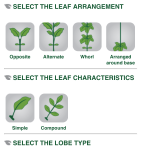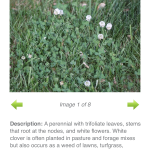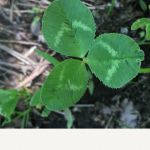Written by Lynn Sosnoskie, WSU Extension

We Americans love our smart phones; and we spend a lot of time on them. According to the statistics portal Statista.com, the average smartphone user in the US spends 2,451 minutes per month using mobile applications (apps). While most of the time we are focused on apps that are designed for socializing, gaming, and other forms of entertainment, it is important to know that there are applications that have been specifically developed to meet agricultural and horticultural needs. Some of these tools can even assist with weed control specifically, by helping growers identify weeds in their production systems.
Why is weed identification important? Simply stated, because not all herbicides are equally effective against all weed species. It is possible (most likely probable) that the weed communities present in orchards are comprised of species that are naturally sensitive to different herbicides or herbicide modes of action. To select the most effective herbicide (of combinations of herbicides), it is crucial that applicators know what species are present at a site.

There are several mobile phone applications designed to help with weed identification, although this article will only cover two: ID Weeds and PlantNet. The ID Weeds app, which was created by the University of Missouri, is primarily focused on species common to the Mid-Western US, but can still be of use to growers in the PNW as many species are common to both regions. This app lets you compile a “list of suspects” by inputting the characteristics that describe your unknown specimen (Figures 1 and 2). These attributes include: whether a species is a grass or a broadleaf weed, where the species is found, how the leaf margins appear, if the leaves and stems are hairy or not, what the flowers look like, and so on. The ID Weeds app then provides information and corresponding images about possible ID matches. You also can search for a weed species, directly, by name (common or scientific) or by selecting a species of interest from an alphabetized list (just as you would use a traditional ID book)
The PlantNet app, developed by four French institutions and the Tela Botanica network, also allows you to search for a species by name and then provides images of that plant for you to view. More importantly, perhaps, this app allows you to upload a picture of a leaf, flower, fruit, or bark and then compares your photo with a database of images using visual recognition software to help you identify your plant of interest (Figures 3 and 4). To increase the chances of proper ID, images should highlight individual plant parts with minimal background distractions. The app provides the user with the opportunity to read more about the species by linking to its Wikipedia entry. Multiple projects are featured in the app allowing users to search through databases of species common to Europe, Canada, the United States, Norther Africa, etc.

The functionality of both apps will continue to evolve with time as species lists are expanded and more information is accumulated. It is not reasonable to expect that these tools will be 100% effective; however, these programs can be very useful when trying to narrow down the spectrum of possible weeds or when trying to identify unknown species in the ‘spur of the moment’. It is always good practice to doublecheck if you are not certain about an identification. Recommended printed guides for identifying weed species include: Weeds of the West, 5th Edition (Burrill et al.) ISBN-10: 0941570134 and Weeds of California and Other Western States (2-Volume Set) (DiTomaso) ISBN-10: 1879906694.
Contact
Lynn M. Sosnoskie, Ph.D.
Assistant Research Faculty
Washington State University
Tree Fruit Research and Education Center
Wenatchee, WA 98801
